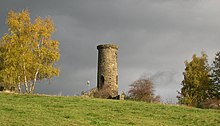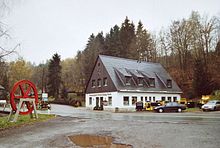Frohnau (Annaberg-Buchholz)
|
Frohnau
Community Annaberg-Buchholz
Coordinates: 50 ° 34 ′ 53 " N , 12 ° 59 ′ 21" E
|
||
|---|---|---|
| Height : | 560 m | |
| Area : | 5.05 km² | |
| Residents : | 936 (June 30, 2011) | |
| Population density : | 185 inhabitants / km² | |
| Incorporation : | January 1, 1996 | |
| Postal code : | 09456 | |
| Area code : | 03733 | |
|
Location of Frohnau in Saxony |
||
Frohnau is a district of the Saxon district town Annaberg-Buchholz in the Erzgebirge district . The silver finds on Schreckenberg led to the founding of the neighboring mountain town of Annaberg in 1496 . The village of Frohnau is best known for the Technical Museum Frohnauer Hammer and the Markus-Röhling-Stolln visitor mine . The mining area around Frohnau is a selected site for the proposed candidacy for the UNESCO World Heritage Ore Mountains Mining Region .
geography
location

The Waldhufendorf Frohnau is located about one kilometer west of the city center of Annaberg. The lower location is in the Sehma valley on the S261 state road . The village stretches along a steep village road in a westerly direction up to the heights of the Schreckenberg .
Neighboring places
| Tannenberg | Schönfeld | |
| Dörfel |

|
Annaberg |
| Schlettau | Buchholz |
history
Although the village is certainly older, the oldest known documentary evidence for Frohnau dates from St. Martin's Day in 1397, when Heinrich I, Burgrave of Meißen, enfeoffed judge Paul Richter zu Rückerswalde with a piece of forest that was cut by a path “ that walks there from Geyersdorff to ghen Fronaw ”. According to a document from 1411, Frohnau, along with Kleinrückerswalde, Geyersdorf, Dörfel and Tannenberg, belonged to the Pöhlberg domain . The place name was interpreted in 1911 by Leo Bönhoff as a combination of the Central German words Fron and awe , i.e. a manorial meadow. Another way of deriving the place name is to interpret the "Frohne" as "Herrenwald", which could be a historical name for the Sauwald .
After, according to legend, Caspar Nietzel found a silver passage on Schreckenberg in October 1491, a mountain scream began. As early as 1493, the first mining regulations were enacted on the Schreckenberg, under the influence of the mining authority in Geyer . Ultimately, the silver finds in 1496 led to the foundation of the "New Town on Schreckenberg", which was given the name St. Annaberg a little later, on the grounds of the mill in Frohnau. Whether the lower mill, the so-called Herrenmühle , or the upper mill on the site of the Frohnau hammer is meant is controversial among the Annaberg local researchers and cannot be definitively proven. In 1498 the young mining town received the right to mint coins from the Wettins. The mill was therefore expanded in the same year to include a mint in which the silver coin known as the Schreckenberger or angel's groschen was minted. The mint was moved to Annaberg as early as 1502 . Frohnau was originally parish to Kleinrückerswalde, but after the construction of the St. Anne's Church in Annaberg it was sent there, where the village is still part of the church today.
As a result, the original farming village of Frohnau, which comprised a field of 8¾ Hufen , was significantly influenced by mining. The high number of cottagers as early as the 16th century testifies to this, most of whom belonged to the miners' profession or related professions such as carpenters or miners. The preserved mountain buildings and heaps of heaps in the corridor bear witness to the past glory of mining in Frohnau. As the most important mine buildings at the beginning of the 19th century, Albert Schiffner names Markus Röhling , King David , the Gallilean economy , the Jung-Andreas-Stolln , Kippenhain with ten thousand thirds , beer beak and farmer's wife .
The Markus-Röhling-Stolln visitor mine can be visited as evidence of the once lively mining activity on site . The hut house , the renovated horse peg and the blacksmith's shop have been preserved on the former mine buildings of the treasure trove . The Frohnau hammer , which was used from 1657 to 1904 as a hammer, gear and weapon hammer is one of the most important examples of the proto-industrial development in the Ore Mountains . It is one of only three preserved of the formerly more than 100 iron hammer mills in the Ore Mountains. It is the first object in Saxony to be designated as a technical monument and has so far been viewed by almost 8 million visitors. The Frohnauer Rundweg connects various mining objects and viewpoints as a mining educational trail over a length of around 10 km .
Frohnau was incorporated into the neighboring district town of Annaberg-Buchholz on January 1, 1996.
Development of the population
|
|
|
sons and daughters of the town
- Ilse Dietze (* 1920), former member of the People's Chamber of the GDR (CDU)
- Volker Bräutigam (* 1939), composer, church musician and university professor
literature
- Frohnau . In: August Schumann : Complete State, Post and Newspaper Lexicon of Saxony. 3rd volume. Schumann, Zwickau 1816, pp. 11-13.
- Frohnau . In: August Schumann : Complete State, Post and Newspaper Lexicon of Saxony. 15th volume. Schumann, Zwickau 1828, pp. 965-967.
- Bernd Lahl : Frohnau on the Silberstrasse. (Ed. Community administration Frohnau) Kugler : Freiberg, approx. 1992.
- Lothar Klapper: 600 years of Frohnau. Forays through the history of the Upper Ore Mountains, issue 8, 1997.
- Lothar Klapper: The Frohnauer School through the ages. Forays through the history of the Upper Ore Mountains, issue 76, 2009.
- Olaf Senger: General Gymnastics Club 1866 Frohnau eV . History of its 140-year existence. 2006 ( erzgebirgsturner.de [PDF; accessed on August 17, 2011]).
- Richard Steche : Frohnau. In: Descriptive representation of the older architectural and art monuments of the Kingdom of Saxony. 4th booklet: Official Authority Annaberg . CC Meinhold, Dresden 1885, p. 71.
Web links
- Frohnau in the Digital Historical Directory of Saxony
Individual evidence
- ↑ a b Lothar Klapper: 600 years of Frohnau. Forays through the history of the Upper Ore Mountains, issue 8, 1997
- ↑ Lothar Klapper: Open questions about the history of the Frohnauer hammer. Forays through the history of the Upper Ore Mountains, issue 56, 2002
- ^ StBA: Changes in the municipalities in Germany, see 1996
- ↑ Cf. Frohnau in the Digital Historical Directory of Saxony





